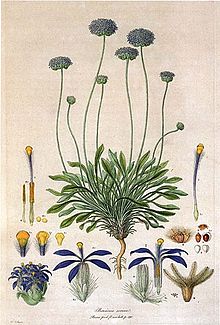- Brunonia
-
For the journal, see Australian Systematic Botany.
Blue pincushion 
Illustration by Ferdinand Bauer Scientific classification Kingdom: Plantae (unranked): Angiosperms (unranked): Eudicots (unranked): Asterids Order: Asterales Family: Goodeniaceae Genus: Brunonia Species: B. australis Binomial name Brunonia australis
Sm. ex R. Br.The blue pincushion (Brunonia australis), also known as Native Cornflower, is a perennial herbaceous plant that grows widely across Australia. It is found in woodlands, open forest and sand plains. In the Cronquist system's classification scheme it was the sole member of the monogenetic plant family Brunoniaceae before the APG II system moved it into Goodeniaceae.
The leaves are about 10 cm long and grow from the base. Flowering is usually in spring, with hemispherical clusters of blue flowers developing on a stem about 50 cm in height.
Taxonomy
Specimens of Brunonia were first collected by Robert Brown during the 1801–02 voyage of HMS Investigator under the command of Matthew Flinders. The genus had not been published by early 1810, when members of the Linnean Society of London sought to name a plant genus in Brown's honour. This genus was settled upon because it was so difficult to classify: "The genus under consideration is... exceedingly interesting, on account of its apparent relationship to several very different natural orders, and the great difficulty of referring it to any one in particular."[1] The name Brunonia was chosen because a genus had already been named Brownea in honour of Patrick Browne, and Brunonia was seen as a compromise, "preserving as much resemblance to his name as possible, while I avoid all ambiguity with the Brownea previously established."[1]
In February 1810, James Edward Smith read a formal description of Brunonia to the Linnean Society. Two species were given: Brunonia australis and Brunonia sericea. Later that year, Brown made use of Smith's names in his Prodromus florae Novae Hollandiae. However, Smith's speech did not go to print until 1811, so priority of publication of the genus belongs to Brown not Smith. Thus Brown unwittingly violated a virtual botanical taboo, by naming a genus after himself.[2]
B. sericea was reduced to a variety of B. australis in 1907, and given synonymy with B. australis in 1992. A number of other species and variety have been published, but to date none have survived as current taxa except B. australis.
Cultivation
This plant is easy to propagate from seed or by dividing existing plants. However, they can be difficult to establish and may die after a few years. They should be grown in well drained soils either in full sun or partial shade.
References
- ^ a b Smith, James Edward (1811). "An Account of a new Genus of New Holland Plants named Brunonia". Transactions of the Linnean Society of London X: 365–370.
- ^ Mabberley, David (1985). Jupiter Botanicus: Robert Brown of the Britush Museum. Lubrecht and Cramer. ISBN 3-7682-1408-7.
- "Brunonia australis". Association of Societies for Growing Australian Plants. http://asgap.org.au/b-aus.html. Retrieved 2008-04-12.
- "Brunonia australis". FloraBase. Department of Environment and Conservation, Government of Western Australia. http://florabase.dec.wa.gov.au/browse/profile/7413.
- Brunoniaceae in L. Watson and M.J. Dallwitz (1992 onwards). The families of flowering plants: descriptions, illustrations, identification, information retrieval. http://delta-intkey.com
Categories:- Asterales of Australia
- Flora of New South Wales
- Flora of the Northern Territory
- Flora of Queensland
- Flora of South Australia
- Flora of Tasmania
- Flora of Victoria (Australia)
- Eudicots of Western Australia
- Monotypic plant genera
- Eudicot genera
- Asterales stubs
- Australian asterid stubs
Wikimedia Foundation. 2010.
